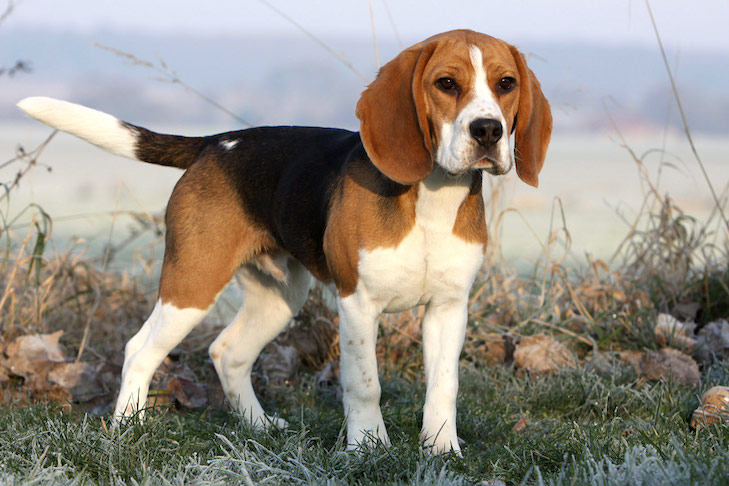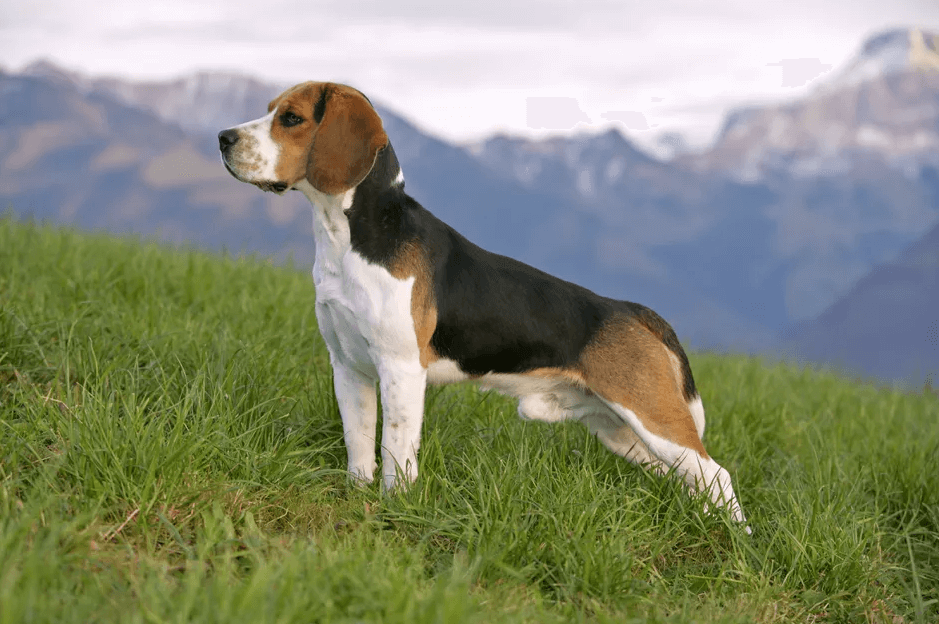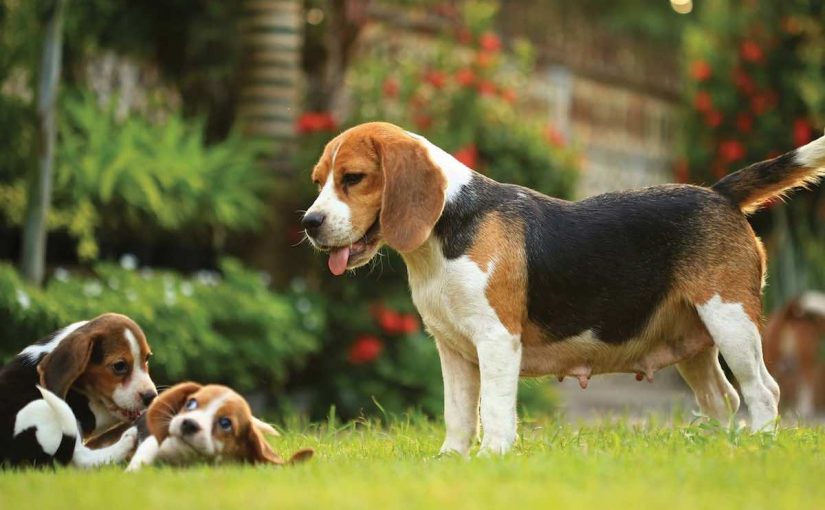Beagle
The Beagle is friendly, sweet, and always searching around for anything tasty to eat. This famous hound dog is friendly, healthy, and excellent with children. Beagles are friendly, fun-loving dogs who like long, leisurely walks with their owners, followed by downtime. Beagles were developed to be hunting dogs and are still driven by their nose. Their keen sense of scent makes them a popular option for small-game hunters, and you'll commonly see them working as detective dogs at U.S. border crossings looking for contraband.
Weight
- Male: 18-24 lbs
- Female: 19-22 lbs
Height
- Male: 13-16 Inches
- Female: 13-15 inches
Life Span
- 12-15 Years
Appearance

The Beagle resembles a tiny Foxhound, and is a tough, resilient little hound dog. The body is constructed squarely, and the head is long and somewhat domed. The square muzzle is modest in length and straight. The big brown or hazel eyes are placed far apart or brown or hazel.
The long and low-set broad pendant ears are wide and pendant. The black nose is vast and has large nostrils. The feet are solid and round. The tail is placed relatively high on the back and never curls. The coat is medium in length, close to the body, firm, sleek, and easy to maintain. Lemon, multicolored, black and tan, red and white, orange and white, lemon and white, blue tick, and red tick are all acceptable hound colors. Beagles have a unique howl/bay of a bark when on the hunt.
Temperament
The Beagle is a friendly, sweet, and gentle dog who greets everyone with a wagging tail. It is gregarious, courageous, and clever. The Beagle gets along well with children and other dogs, but due to its hunting tendencies, it should not be trusted with non-canine pets unless it has been socialized with cats and other domestic animals since it was a puppy. They are tenacious and vigilant, and they demand careful, arduous instruction.
Beagles, while they might be wary of strangers at first, they gradually warm up to them (which makes for a poor guard dog). They're also energetic, which means they'll scream and bark if anything isn't suitable (which makes for a good watchdog).
A hound-type dog's instinct to follow one's nose is a distinguishing trait. A Beagle will be single-minded when it comes to an intriguing smell, and you'll need a leash and a solid arm to reclaim them. Like other scent-seeking dogs, Beagles will discover and consume items you don't want them to. Another fascinating Beagle fact is that when they detect a strong scent, they may vocalize in a manner known as baying, which was initially used to guide hunters to the location of prey.
Living Conditions

A beagle is happiest when they have an owner who will make use of her scent-tracking abilities, whether through hunting, competitions, or hours-long treks or walks around the neighborhood, and who can spend enough quality time with her. Beagles are prone to loneliness, and if they are left alone for an extended period or are not adequately exercised and taught, they might acquire undesired habits.
Beagles are high-energy canines that were bred to go on lengthy hunting trips. This means that they will require regular exercise, preferably in the form of lengthy walks, whether they live in an apartment or on a farm.
It's a good idea to secure the exits to keep the Beagle's unquenchable hunger for locating the delicious smell in check. You might want to look around your yard to determine any possible escape routes for your dog if he detects a tempting scent.
These dogs are consistently kind to children, making them ideal family pets. They also get along with other pets in the house, such as cats. Beagles are known for always putting their heads to the ground, seeking the next best smell to follow. They were bred as scent hounds who hunt in packs; as a result, beagles must either live in a house with a fully protected and ideally strengthened fence or have enough outside access for long, flowing leash walks.
Care

The Beagle's short, weather-resistant coat is easy to keep, but it comes at a cost: it sheds a lot. Brushing your Beagle two to three times a week can prevent dead hair from accumulating in your house and encourage the growth of new, healthy hair. Because she has a double coat, she will shed significantly in the spring, and you should brush her regularly.
The good news is that your Beagle shouldn't require a bath more than three or four times a year unless he gets himself into anything nasty, which is a distinct possibility.
Cleaning ears: Use a solution prescribed by your veterinarian to clean your Beagle's drooping ears. Cotton swabs should not be used inside the ear since they might push muck farther down.
Wipe the ear out with a cotton ball, avoiding going more profound than your first knuckle. Trim their nails regularly, generally every two weeks. They should never be so lengthy that they make a clicking sound on the floor.
Health
Beagles are a reasonably healthy dog breed, although they have a higher incidence of some health issues than other breeds. Epilepsy, hypothyroidism, "cherry eye," disk disorders, dwarfism, immune-mediated polygenic arthritis, and cerebellar cortical degeneration are all examples. Keep a check on their ears for general health reasons since they are more susceptible to ear infections because of their size and floppiness.
Patellar luxation, glaucoma, central progressive retinal atrophy (CPRA), distichiasis, chondrodysplasia, and keratoconjunctivitis sicca are other issues that need to be monitored.
Beagles have a voracious appetite and are prone to become overweight. It's critical to accurately measure each meal, considering any training rewards and in-between snacking. This high-energy breed requires at least an hour of daily exercise, and lengthy walks keep them physically and psychologically healthy.
You should be prepared for any difficulties that may arise throughout your dog's life, regardless of how healthy they are when you initially brought them home. A pet insurance plan can help you prepare for any veterinary requirements your Beagle may have.
History

The name beagle is supposed to have originated from a combination of old French words that meant open throat, implying a link to the dog's melodic bay. It's also possible that the dog's name came from a combination of old French, Celtic, and English terms that meant "little." Although beagle-like dogs were undoubtedly used in England throughout the 1300s for the popular pastime of hare-hunting, the word beagle was not used until 1475.
Hunters would trail the dog on foot and, in some cases, carry one in his pocket. In the 1800s, Beagles came in various sizes, but pocket-sized canines were the most popular. These little canines were just nine inches tall and needed the hunter's assistance across rugged terrain. Women, the elderly, and those who lacked the endurance or willingness to keep up with an energetic dog favored the smaller Beagles since they were slower and easier to follow on foot.
In the 1800s, England and Scotland improved and standardized beagles, culminating in the Beagle we know today. The breed as we know it did not officially arrive in the United States until after the Civil War when American breeders began importing English beagles.
The breed's popularity exploded on this side of the Atlantic. The American Kennel Club recognized the Beagle in 1885, and it is now the seventh most popular dog breed in the United States.
Final Thoughts
Beagles are one of the most affectionate dog breeds. They are adored by everybody and take little effort to get along with. Beagles do demand a lot of activity on a daily basis and are a good choice are a great choice if you want to have a satisfying connection with your dog and are very active.








Comments